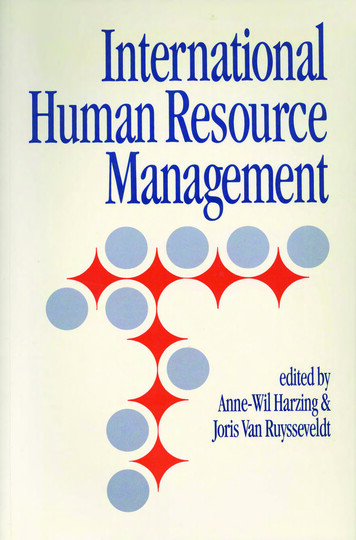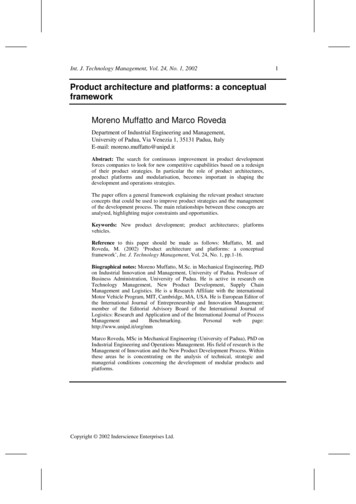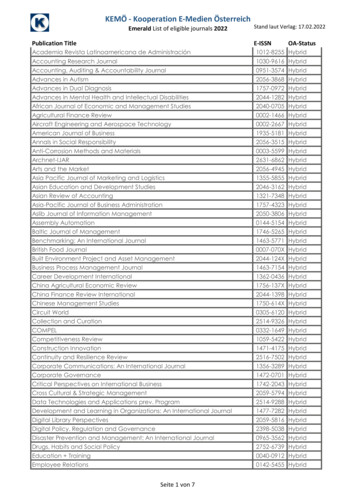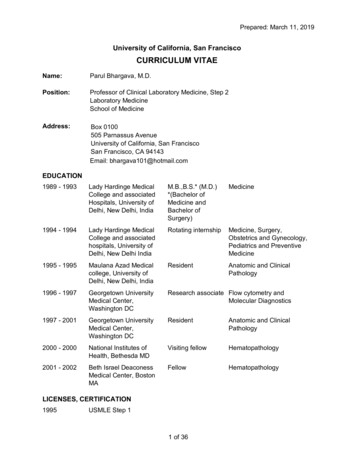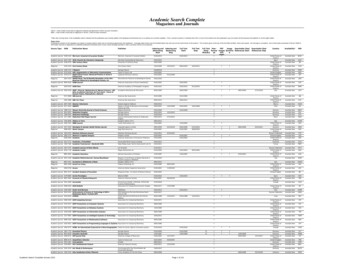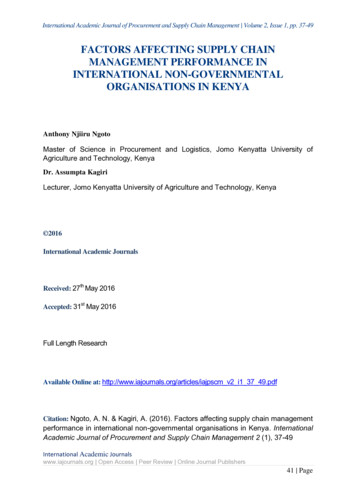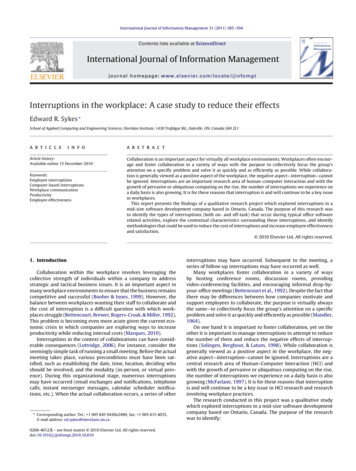
Transcription
International Journal of Information Management 31 (2011) 385–394Contents lists available at ScienceDirectInternational Journal of Information Managementjournal homepage: www.elsevier.com/locate/ijinfomgtInterruptions in the workplace: A case study to reduce their effectsEdward R. Sykes School of Applied Computing and Engineering Sciences, Sheridan Institute, 1430 Trafalgar Rd., Oakville, ON, Canada L6H 2L1a r t i c l ei n f oArticle history:Available online 15 December 2010Keywords:Employee interruptionsComputer-based interruptionsWorkplace communicationProductivityEmployee effectivenessa b s t r a c tCollaboration is an important aspect for virtually all workplace environments. Workplaces often encourage and foster collaboration in a variety of ways with the purpose to collectively focus the group’sattention on a specific problem and solve it as quickly and as efficiently as possible. While collaboration is generally viewed as a positive aspect of the workplace, the negative aspect—interruption—cannotbe ignored. Interruptions are an important research area of human–computer interaction and with thegrowth of pervasive or ubiquitous computing on the rise, the number of interruptions we experience ona daily basis is also growing. It is for these reasons that interruption is and will continue to be a key issuein workplaces.This report presents the findings of a qualitative research project which explored interruptions in amid-size software development company based in Ontario, Canada. The purpose of this research wasto identify the types of interruptions (both on- and off-task) that occur during typical office softwarerelated activities, explore the contextual characteristics surrounding these interruptions, and identifymethodologies that could be used to reduce the cost of interruptions and increase employee effectivenessand satisfaction. 2010 Elsevier Ltd. All rights reserved.1. IntroductionCollaboration within the workplace involves leveraging thecollective strength of individuals within a company to addressstrategic and tactical business issues. It is an important aspect inmany workplace environments to ensure that the business remainscompetitive and successful (Booher & Innes, 1999). However, thebalance between workplaces wanting their staff to collaborate andthe cost of interruption is a difficult question with which workplaces struggle (Bettencourt, Brewer, Rogers-Croak, & Miller, 1992).This problem is becoming even more acute given the current economic crisis in which companies are exploring ways to increaseproductivity while reducing internal costs (Marques, 2010).Interruptions in the context of collaborations can have considerable consequences (Lottridge, 2006). For instance, consider theseemingly simple task of running a small meeting. Before the actualmeeting takes place, various preconditions must have been satisfied, such as establishing the date, time, location, deciding whoshould be involved, and the modality (in-person, or virtual presence). During this organizational stage, numerous interruptionsmay have occurred (email exchanges and notifications, telephonecalls, instant messenger messages, calendar scheduler notifications, etc.). When the actual collaboration occurs, a series of other Corresponding author. Tel.: 1 905 845 9430x2490; fax: 1 905 815 4035.E-mail address: ed.sykes@sheridanc.on.ca0268-4012/ – see front matter 2010 Elsevier Ltd. All rights uptions may have occurred. Subsequent to the meeting, aseries of follow-up interruptions may have occurred as well.Many workplaces foster collaboration in a variety of waysby hosting conference rooms, discussion rooms, providingvideo-conferencing facilities, and encouraging informal drop-byyour-office meetings (Bettencourt et al., 1992). Despite the fact thatthere may be differences between how companies motivate andsupport employees to collaborate, the purpose is virtually alwaysthe same—to collectively focus the group’s attention on a specificproblem and solve it as quickly and efficiently as possible (Mandler,1964).On one hand it is important to foster collaboration, yet on theother it is important to manage interruptions to attempt to reducethe number of them and reduce the negative effects of interruptions (Solingen, Berghout, & Latum, 1998). While collaboration isgenerally viewed as a positive aspect in the workplace, the negative aspect—interruption—cannot be ignored. Interruptions are acentral research area of Human–Computer Interaction (HCI) andwith the growth of pervasive or ubiquitous computing on the rise,the number of interruptions we experience on a daily basis is alsogrowing (McFarlane, 1997). It is for these reasons that interruptionis and will continue to be a key issue in HCI research and researchinvolving workplace practices.The research conducted in this project was a qualitative studywhich explored interruptions in a mid-size software developmentcompany based on Ontario, Canada. The purpose of the researchwas to identify:
386E.R. Sykes / International Journal of Information Management 31 (2011) 385–3941. The types of interruptions (both on- and off-task) that occur during typical office computer-based activities (e.g., Visual Studiodevelopment environment, SQL Server query builder, etc.).2. The characteristics of these interruptions—from the interruptionnotification modality to the interruption task itself.3. Methodologies that could be used to reduce the cost of interruption and increase employee effectiveness and satisfaction.This research provided insight into the very nature of interruptions in this software development workplace environment.It also focused on constructing guidelines that could be fosteredby the company to reduce the negative effects and frequency ofinterruptions while still maintaining a sustainable level of healthycollaboration.2. Interruption literature reviewInterruptions happen for a multitude of reasons. The purposeof an interruption could be to answering a telephone, respondto an instant message notification, or to address a colleaguewhen she comes by your office. Regardless of the purpose ofthe interruption, there are four known strategies for managing interruption: (a) immediate, (b) scheduled, (c) negotiated,and (d) mediated (Allen, Guinn, & Horvitz, 1999; McFarlane,2002).The immediate interruption strategy involves interrupting theperson immediately regardless of what they are doing in a waythat insists that the user immediately stop what they are currentlyworking on and respond to the interruption. The scheduled strategy involves restricting the agents’ interruptions to a prearrangedschedule, such as, send a meeting notification 15 min before itstarts. The negotiated interruption strategy would have the agentannounce their need to interrupt and then support a negotiationwith the person. This approach gives the user full control overhow to deal with the interruption—when or even at all. For example, many email clients have a popup indicating receipt of a newmail message or small icon in the Task pane indicating the same.These indicators make the user aware and let them choose when todeal with the email message. The fourth strategy, called mediated,involves agents indirectly interrupting and requesting interactionthrough a broker like a Smartphone. The Smartphone would thendetermine when and how the agents would be allowed to interruptthe user.A case study conducted by Solingen at a software developmentcompany identified three types of interrupts: personal visits, telephone calls and emails (Solingen et al., 1998). They discovered thatpersonal visits and telephone calls caused 90% of all interrupts andemail caused the rest (Solingen et al., 1998). The results showedthe effort spent on interrupts required an average of 20 min foreach occurrence, including the time spent handling the interruption task, and that each developer receives between three and fiveinterrupts per day. Approximately 1.5 h per day of the developer’stime was consumed on dealing with interruptions (Solingen et al.,1998).The following section discusses the following issues surrounding the topic of interruptions: (a) tasks and task boundaries, (b)attention and attentional draw, (c) cognitive load, cost of interruption and resumption lag, and (d) multi-tasking. This list issufficiently inclusive since it is an established framework that isused by HCI interruption researchers (Gluck, Bunt, & McGrenere,2007; Hodgetts & Jones, 2007; Mandler, 1964; McFarlane, 2002;McFarlane & Latorella, 2002; Preece et al., 1994; Xiao, Stasko, &Catrambone, 2004).2.1. Tasks and task boundariesAs humans, we are generally very good at negotiating when isan appropriate time to interrupt another person (Mandler, 1964,1975). For instance, consider a typical office environment in whichyou are interested in asking a colleague a question. Contextualawareness of your colleague’s task, other office activities, the person’s facial cues and body language are all used, albeit possiblysubconsciously, in your assessment and ultimate decision in determining if this is an appropriate time to interrupt him/her or to leavehim/her to their current task. However, and fortunately for interruption researchers, in many situations, there are some obvioustimes during a person’s activities when it is an ideal moment tointerrupt a person or not. For instance, continuing the previousexample, suppose you observe your colleague is busy on the phone,or you hear a conversation. Naturally, you decide to wait until s/he isoff the phone or the conversational noise level stops. For computerbased tasks, task breakpoints can be identified by the interrupterbased on the following criterion: attention to the current task, criticality of the current task, and current stage within the task (Gievska& Sibert, 2005).Unfortunately, computers and computer systems with interruption mediators are not as sophisticated as people’s reasoningabilities. Task and interruption researchers are interested in acquiring contextual information surrounding the task so that the timingof the interruption and the information presented will be of theutmost benefit to the user at that time (Iqbal & Bailey, 2007). Inmany situations if it is possible to defer an interruption to a taskbreakpoint (or task boundary), the inconvenience to the user byresponding to the interruption is significantly reduced (Iqbal &Bailey, 2007). In these situations, the resumption lag is much less forthe user than if the interruption occurred during the task (Horvitz,Koch, & Apacible, 2004). In one interruption mediator system, aset of microphones is placed throughout the office to monitor conversational noise levels. These microphones in combination withan eye tracking system that monitors where the user is currentlyfocusing his/her attention is used to provide the contextual data tothe interruption mediator (Horvitz, Kadie, Paek, & Hovel, 2003). Inthis system, if the user turns his/her head away from the computerto talk to a colleague standing at his/her office doorway, then thesystem notes that the user is essentially disengaged with the current task and any message should be deferred until the user returnshis/her focus to the computer (Horvitz et al., 2003). Similarly, themicrophones are used to provide input to the system as to whetherother people are in the office or if the user is on the phone (Horvitzet al., 2004).2.2. Attention and attentional drawBy far the most popular form of interruption that computer usersencounter on a day-to-day basis is email notifications and instantmessenger client pop-up messages (Gievska, Lindeman, & Sibert,2005; Horvitz & Apacible, 2003; Iqbal & Bailey, 2007). For the content of the interruption to be presented to the user, the user mustfirst acknowledge the interruption—in other words the user mustbe attentive to the interruption notification.The process by which an interruption notification methodattracts the user’s attention is called attentional draw (Gluck et al.,2007). A number of computer-based interruption systems havebeen developed that vary the degree of attentional draw based onthe importance of the message (Gluck et al., 2007). Consider anemail client presenting a message of high-priority appearing in thecenter of the user’s screen which requires the user to acknowledgethe message versus a low (or normal) priority message that wouldappear in a less obstructive location (say, the bottom right area ofthe user’s screen) and then fade away automatically after 10 s. In
E.R. Sykes / International Journal of Information Management 31 (2011) 385–394this section a discussion of attention and attentional draw researchis presented (Horvitz et al., 2003). In order for an interruption tobe meaningful, the user must pay attention to the interruptionand the content it discloses. Furthermore, depending on the user’slevel of attention, level of distraction, and working environment aninterruption message may not even be noticed (Horvitz & Apacible,2003).Associated with interruption research is determining the bestway in which to present a message to the user—this is the topiccalled attentional draw. A study conducted by Gluck et al. (2007)examined matching attentional draw with the utility of the interruption message (Gluck et al., 2007). This study had the followingdesign guidelines (Gluck et al., 2007):1. to increase the positive perception of interruptions (i.e., from apsychological computer-human interface perspective);2. to match the interruption’s notification method (i.e., the attentional draw) to the utility of the content of the interruption;3. to perform an empirical investigation to examine the effects ofmatching attentional draw of notification to interruption utilityin terms of annoyance, perceived benefit, workload, and performance (Gluck et al., 2007).The findings of this research show that when the utility of theinterruption is known to the user, interfaces that change the attentional draw based on utility result in decreased annoyance andincreased perception of benefit compared to interfaces that use anunchanging level of attentional draw (Gluck et al., 2007).2.3. Cognitive load, cost of interruption and resumption lagAnother aspect relating to tasks, attentional and attentionaldraw is the assessment of the cognitive load placed on the userwhile performing a task (Allen et al., 1999; Gievska & Sibert, 2004;Gluck et al., 2007; Horvitz & Apacible, 2003; Iqbal & Bailey, 2005).This section relies on the following definitions. Cognitive load is anindicator of the degree of working memory utilized when the useris performing a task (Yin & Chen, 2007). The Cost of Interruption(COI) is a subjective measure of price a user would pay to remainundisturbed while working on a computer-based task (Horvitz &Apacible, 2003; Horvitz et al., 2004). The COI may include variouskinds of alerts disrupting a user in different contexts (Horvitz &Apacible, 2003; Horvitz et al., 2004). The COI has been used as anassessment tool for several decades in decision analysis in variousfields (Horvitz et al., 2004). Horvitz’ definition for the expected COIis:j p(Sj E)X(Di , Sj ), where C is the cost to be inferred of the userbeing interrupted by different types of disruptions D conditionedon being in states, S, C(Di , Sj ) (Horvitz et al., 2004). ResumptionLag (RL) is defined as the time required to resume the primarytask after completing the interrupting task (Iqbal & Bailey, 2005).RL can be measured as the time from closing the interruptingtask to the first keyboard or mouse action in the primary taskin direction of the task goal (Iqbal & Bailey, 2005). The COI canbe indirectly measured from the RL (Horvitz et al., 2004; Iqbal &Bailey, 2007). A greater RL implies a greater COI (Horvitz & Apacible,2003).There is a strong correlation between cognitive load and the costof interruption (Baylor & Yanghee, 2005; Gievska et al., 2005; Iqbal& Bailey, 2005). Thus, it is important to assess the cognitive load onthe user while s/he is performing a task in order to decide whetheror not to interrupt the user (Gievska & Sibert, 2004; Gluck et al.,2007; Iqbal & Bailey, 2005).Researchers have shown that if a user is interrupted during ahigh cognitive load task by being forced to switch tasks (e.g., toread a message, talk with a colleague, or to perform the interruption task), then the cost of interruption can be very high (Baylor &387Yanghee, 2005; Gievska et al., 2005; Iqbal & Bailey, 2005). There isa strong correlation between cognitive load and the cost of interruption (Baylor & Yanghee, 2005; Gievska et al., 2005; Iqbal &Bailey, 2005). Furthermore, studies have also shown that humanwork efficiency drops significantly in noisy environments becauseof the negative effects on concentration (Zaheeruddin & Garima,2006).2.4. Multi-taskingComputer users often multitask (Iqbal & Horvitz, 2007). Dueto the fact that there are so many applications available to computer users, the degree of multitasking has significantly increasedin the last 30 years (Bannon, Cypher, Greenspan, & Monty, 1983).It is common for users to run a word processor, browser, instantmessenger, email, and calendar all at the same time (Horvitz et al.,2003). Unfortunately, multitasking has downfalls:1. Multitasking is less efficient. This is because multitasking isresource intense. Like a computer system, the CPU can beassigned and unassigned tasks by using the Program ControlBlock which houses all the pertinent information regarding atask. For a computer system to swap tasks requires time andresources. For a human to switch tasks is even more involved andcostly. This is due to the fact that the mental requirement andsometimes physical requirement can be very high. For instance,consider a user moving paper documents to the file cabinet tomake room to work on documents from another file folder. Theperson must then mentally try to remember the state s/he was inbefore the job was suspended. Depending on various factors thismay take quite some time (Newell, 1990; Salomon, Perkins, &Globerson, 1991). For computer based tasks, the analogy applies.The cost of interruption in computer multitasking can be veryhigh since the user must change state for the new task, and thenswitch back again (Griffiths et al., 2004).2. Multitasking is more complicated. From the previous example itshows that for a user to change tasks and at a later time changeback again requires a degree of overhead in terms of management and mental awareness of the state of each task prior to itssuspension. From a psychological perspective, researchers haveshown that users who multitask extensively have felt additionalstress and are more likely to make errors (Griffiths et al., 2004;Regian, 1997; Salomon et al., 1991). Thus, at a minimum, computer based task switching is more involved and complicated.3. Multitasking can be self-directed. Another user characteristicassociated with multitasking is that it is often self-directed, thatis, it is an innate property of the user to perform more than onetask at a time. In other words, the user has a choice to switcha task or to remain focused on the current task. However, thereare situations where task switching is imposed on the user suchas alerts, message notifications, etc., which is a one of the areasof investigation in this research.Regardless, multitasking is here to stay and appears to be growing steadily among computer users around the world (Horvitz,1999; Iqbal & Bailey, 2007; Kapoor & Picard, 2005; Microsoft, 2007;Preece et al., 1994). Architects for interruption systems must recognize this aspect of user behaviour in designing new systems.2.5. Interruption literature—guideline summaryThe main points from the previous discussion on interruption inthe workplace are summarized below and serve as the fundamentalframework for the addressing the research goals:
388E.R. Sykes / International Journal of Information Management 31 (2011) 385–394Fig. 1. Office workplace layout.1. Recognize that there is a cost associated with every interruptionand after the interruption is addressed, there is a cost associatedwith resuming the original task (Gievska et al., 2005).2. Task boundaries should be observed and used to guide decisionmaking for interruption points (Hodgetts & Jones, 2007; Solingenet al., 1998).3. For high cognitive load tasks the cost of interruption is high. Inthese situations, it is best to wait until the task is complete orthe user reaches a task boundary (Adamczyk & Bailey, 2004).4. Wherever possible the potential for office distractions should bereduced. For example, a cluttered desk with stacks of paper orwalls with numerous posters should be avoided (Horvitz et al.,2003).5. Notification awareness methods should be congruent with thesignificance of the message (Mandler, 1964).6. Interruptions can influence the personal state, specifically thenegative emotions, such as, irritation, or frustration (Mandler,1975).7. Office noise, such as voices from colleague’s discussions, onesided telephone conversations, computer equipment, etc. shouldbe minimized as much as possible (Horvitz et al., 2003).3. MethodThe purpose of this research was to identify the types of interruptions that occur during office software related activities, explorethe contextual features surrounding these interruptions, and identify techniques that could be used to reduce the negative impactof interruptions. This section discusses the method that was car-Table 1Methodologies for data collection (adapted from: Frías-Martínez et al., 2004; McFarlane, 2002).Accuracy of detailscaptured of theinterruption scenario Non-intrusivenessto the participantEase of data collection Video recording (participant’scomputer screen) Video recording (participant’s face,head, andshoulders) Event logger(keyboard, mouse,active applications,etc.) Remotedesktop/VNC Researcherobservation Survey Legend: () (extremely suitable), () (very suitable), () (suitable), ( ) (slightly suitable), ( ) (sliightly unsuitable),( ) (extremely unsuitable).Ease of data analysisSetup time ( ) (unsuitable), ( ) (very unsuitable),
E.R. Sykes / International Journal of Information Management 31 (2011) 385–394InitialCOIInterruptionnotificationPrimary taskt0ResumptionlagInterruptiontaskt1 t2 t3InitialCOIInterruptionnotificationt4 t5ResumptionlagInterruptiontaskPrimary taskt6t7 t8389Primary taskt9 t10Time (s)Fig. 2. Sample interruption timing scenario—alternating states between primary and interruption tasks.ried out for this research. In this section, the following topics arediscussed: Office layout,Data collection technique,Types of interruptions,Measures,Selection process for participants, andProcedure.3.1. Office layoutEach cubical in the workplace is approximately 7 (width) 8 (length) 4.5’ (height), equipped with a computer, telephone andstandard office materials. The office layout is presented in Fig. 1. Thefigure shows two participants (P1 and P2 ) and a Colleague, Ci interacting with the respective participant. The walkways are quite long(approximately 25 m) off which are many similar cubical offices.3.2. Data collection techniqueA number of data collection techniques were reviewed to determine the most suitable method for this research. The techniquesselected for consideration have been used for similar research studies (Jackson, Dawson, & Wilson, 2003).There are several ways in which the details of office interruptions could have been recorded. One way would be to recordthe employees at their desk, carrying out various activities andcapturing the information by using a video recorder. Another possibility would be to have an actual person watching the employeeat their desk from a distance. While this approach has bias sinceother employees may not drop by the participant’s office asoften as without the researcher present or perhaps the way inwhich the participant performs his/her work may be differentwith the researcher present (Patton, 2002). However, through random observations and unobtrusive observational techniques, thisapproach can be quite satisfactory (Patton, 2002).The last option considered was to use computer software tomonitor the employee (e.g., VNC, Windows Remote Desktop, etc.).Table 1 presents the characteristics of different data collection techniques along five criteria. The criteria are based on (Frías-Martínez,Magoulas, Chen, & Macredie, 2004):1. Accuracy of details captured of the interruption scenario;2. The degree of non-intrusiveness to the participant;3. Ease of data collection, including the management and storageof the data;4. Ease of data analysis;5. Setup time.Table 1 shows the pros and cons of the selected data collection methodologies were identified and ranked using guidelinesfrom the literature (see: Frías-Martínez et al., 2004; Jonassen, 1994;Kahneman, 1973; McFarlane, 2002). The company deemed thevideo recording method inappropriate, as it would be too intrusivefor employees to their daily activities. It was decided that detailedresearcher observational note-taking with a digital stopwatch wasthe most appropriate method for this research and ensured company compliance. This approach offers rich contextual informationto be collected during office interruptions.3.3. Types of interruptionsSeveral different types of interruptions were of interest in thisresearch. During the researcher observations, the type of interruption and rich contextual information was recorded. The types ofinterruptions observed were the following:1. telephone,2. Instant Messenger, and updating system notifications (e.g., Windows update, Adobe, Java, etc.),3. email notifications,4. colleague initiated discussion in the participant’s office, and5. distractions (e.g., surrounding office noises, such as, fans, doors,people walking by, nearby conversations, nearby washroom,etc.).3.4. MeasuresThe measures for this research included:1. Interruption details (time, type, and contextual information).2. The cost of the interruption (time, perceived irritation/disturbance to the participant), and3. The resumption lag time.Fig. 2 illustrates a sample interruption timing scenario. The figure shows the primary task and interleaving interruption tasks, theinterruption notification, the cost of interruption and resumptionlag times.The data collected was confidential and agreements betweenthe researcher and the company were established to protect thecompany’s core business and the participants involved in the study.The following conditions were strictly adhered:1. All information collected on participant activities would onlybe viewed by the researcher, who carried out the research incooperation with the company.2. A non-disclosure agreement was signed by the researcher withthe company.
390E.R. Sykes / International Journal of Information Management 31 (2011) 385–394Table 2Observations of participant: P1 .InterruptionPrevious/primary taskType of interruptionInitial cost of interruptionTime spent on the interruption taskResumption lag timeint1int2.inti.intnTable 3Number of interruptions encountered by Technical Leads and Senior Developers level participants during an 8-h work day.Type of interruptionAverage number of interruptionsAverage interruption lengthColleagueMessengerEmailTelephone40 (range: 24–56)9 (range: 8–10)52 (range: 32–72)20 (range: 8–32)2.8 h (range: 1.6–4)0.5 h (range: 0.13–0.8)1.8 h (range: 1.6–2.0)0.7 h (range: 0.6–0.8)Total1215.7 hTable 4Number of interruptions encountered by Staff and Associate level participants during an 8-h work day.Type of interruptionAverage number of interruptionsAverage interruption lengthColleagueMessengerEmailTelephone12 (range: 8–16)4 (range: 0–8)8 (range: 0–16)060 min (range: 24–96)1.2 min (range: 0–24)12 min (range: 0–24)0 minTotal2473.3 minFig. 3. (a) Breakdown of the times spent in serving different types of interruptions at the Technical Lead/Senior Developer level and (b) the length of these interruptionsduring an 8-h work day.Fig. 4. (a) Breakdown of the times spent in serving different types of interruptions at the Associate/Staff level and (b) the length of these interruptions during an 8-h workday.
E.R. Sykes / International Journal of Information Management 31 (2011) 385–3943. The results would be disclosed to the company as overall totals,averages and general observations—no individually identifiableinformation would be supplied to the company.4. The results would be used to benefit the company as a whole,including all its employees.391Table 5Number of distractions encountered by all positions involved in the study duringan 8-h work day.3.5. Selection process for participantsAn open invitation was sent all employees in the software development group. In this company four different positions (levels)were represented in the research study. One or more employees from each of these positions were invited to participate. Theresponse rate was 86%, indicating the employees invited had a distinct interest in participating in the study. These positions were(most senior listed at the top):1. Technical Lead. This position involves being a software projectmanager for 1–2 projects each involving 3–5 Staff and Associatelevel personnel.2. Senior Developer. A senior developer has several years of softwaredevelopment experience on at least three different projects. Thisposition involves working on a project with the Technical Leadand with Staff and Associate level colleagues.3. Staff. This position involves working on projects with a SeniorDeveloper and a Technical Lead. Staff level personnel workclosely with Associate level colleagues.4. Associate. This is an entry level position. An Associate works withStaff on a regular basis and reports to a Senior Developer.Four employees volunteered to participant in the case studyfrom all position levels of the company. Although the resultsobtained are only relevant to this software company, a degree ofge
Edward R. Sykes School of Applied Computing and Engineering Sciences, Sheridan Institute, 1430 Trafalgar Rd., Oakville, ON, Canada L6H 2L1 . strategic and tactical business issues. It is an important aspect in . 386 E.R. Sykes / International Journal of Information Management 31 (2011) 385-394 1. Thetypesofinterruptions(bothon-andoff .




